The Story of Culture and Arts
- Image resource of Korean history
- Documents from History TextBooks
- Culture & Art Stories from Korean History
- Culture & Art Stories from Korean History - Korean
- National Institute of Korean History
- History net
- About the site
- Introduce
-
Numerous topics related to Korean culture and art are mentioned in middle and high school national history textbooks, but most of them are briefly described by era, making it difficult to understand their concepts, transition processes, and characteristics.
<Culture & Art Stories from Korean History> produces and provides video materials based on expert commentary on the flow, change process, characteristics and characteristics of each major topic in the field of culture and art in Korean history.

Scenario
This museum researches and exhibits traditional Korean clothes. They are pulling out some 18th-century garments from storage. It is a long coat and a sleeveless vest from an old military uniform.
“The coat with bright red and yellow sleeves is called a dongdali. The Chinese-derived word for sleeve is “dong.” So dongdari means “sleeves that differ from the trunk.” Hwang Jin Young, curator / Seok Juseon Memorial Museum
Red, yellow, and blue lining! What do you think? Aren’t the colors of traditional Korean clothing splendid? Their beauty is timeless. How did people produce so many colors back then? A wide array of natural textiles and glimmering colors! Let’s hear the story of the five cardinal colors.
The Original Canvas for Traditional Dyeing, Traditional Textiles
When did Koreans first begin weaving fabric for clothing? Here we see objects used to wind fibers, such as a spindle whorl and bones needles. People in Korean peninsula began weaving and utilizing textiles during the Neolithic period around 5,000 BCE. The oldest fabrics found to date are hemp cloth and silk dating from the 1st century BCE.
When [the people of Buyeo] go out from their state, they favor silken brocades, embroidered fabrics, and wool cloth. - Sanguo ji (Records of the Three Kingdoms), “Book of Wei,” Volume 30, “Biographies of the Eastern Barbarians”
Korea has been a producer of textiles since before the Three Kingdoms period. For the Three Kingdoms period, we can find several traces of its fabrics and dyes today.
Those rank six or higher were ordered to dress in purple, with headpieces decorated with silver flowers. Those rank eleven or higher were ordered to wear red clothes, and those rank sixteen or higher were to dress in blue. - Samguk sagi (History of the Three Kingdoms), Book 24, Annals of Baekje, Year 27 of King Goi (260 CE)
For the first time, state codes were promulgated; government officials were to wear uniforms in vermillion or purple to denote their ranks. - Samguk sagi (History of the Three Kingdoms), Book 4, Annals of Silla, Year 7 of King Beopheung (520 CE)
“When you examine the government offices section of the Samguk sagi, you can see there was a weaving office and a dyeing office. They placed a lot of importance on dyeing. In ancient societies, color played a critical role in displaying one’s rank. This is why there were several dye experts in public office.” Cho Hyosook, Professor / Gachon University
Beginning in the Three Kingdoms period and continuing into the United Silla Period, a weaving method was developed where silk fabrics were woven using multiple colored threads. By the Goryeo period, gold thread was interwoven to create gold brocades. You can see this phenomenal Goryeo weaving and dyeing technique in the monk’s robes enshrined in several Buddha statues.
Yet, entering the Joseon period, the production of high-quality textiles began to decline as ramie, cotton, hemp, and silk came into the spotlight, cotton being the most crucial.
The White-Clad Nation Embraces the Five Cardinal Colors
Koreans commonly refer to themselves as “the white-clad nation.” Many records cite their preference for white clothing.
For their dress…they favor white; they have white gowns with large sleeves and trousers, and on their feet, they wear leather sandals. - Sanguo ji (Records of the Three Kingdoms), “Book of Wei,” Volume 30, “Biographies of the Eastern Barbarians,” “Buyeo”
White is made by bleaching the fabric.
“The traditional method of bleaching a naturally colored (not dyed) garment white was through a scouring process. Burn beanstalks and reduce them to ash. Then add boiling water. Once the ash settles, the top layer is your lye water. Take the lye water and bring to a boil. Then boil the cloth in the lye water, dry it, and repeat. Repeat this process until the cloth is bleached white. This is how you make the color white.” Chung Kwanchae / Master Indigo Dyer, Important Intangible Cultural Heritage
Koreans may love the color white, but that isn’t their only traditional color. Natural colors, like the red, blue, yellow, and black found in plants and minerals, were also frequently used.
“This is the indigo plant. Its seeds are planted in February, and little sprouts appear by March. Right now, it's about mid-June, and they've grown very nicely. The blue pigment is inside the green leaf. Indigo dyeing involves extracting that pigment, turning it into a dye, and then dyeing a textile.” Chung Kwanchae / Master Indigo Dyer, Important Intangible Cultural Heritage
Traditional blue pigment is made from indigo. It’s made on swelteringly hot days; the hotter the weather, the better the pigment separates. Fully grown indigo leaves are soaked in water for two days, after which the blue color begins to separate.
Calcium hydroxide made from crushed and roasted clam shells is added to the indigo water and stirred thoroughly. Once thoroughly mixed, the mixture will settle. The sediment at the bottom is the raw ingredient of indigo dye, niram. Add niram to the lye water and let it ferment. Your indigo dye solution is now ready.
“… This blue color comes from these green leaves. But it’s a deep blue, like that of the deep blue sky and the deep blue sea.”
From a clear sky blue to a deep ocean blue. Indigo dyeing, Korea’s principal form of dyeing, can produce a wide variety of shades of blue.
But there is another major dyeing method in Korea, hongyeom, or crimson dyeing. Red is a traditionally precious color.
The dye is made by putting safflowers, or red flowers, and fermented omija vinegar into a vat of lye water. In the Joseon Dynasty, there was a particular shade of red that could only be used by the royal family called “daehong” or “great red.”
“You need to repeat the dyeing process at least 30 times to get a pure, beautiful crimson color. At some point after that, the pure red color turns murky. There comes a point when it loses its beauty and turns a blackish red. It is just before that tipping point, when it begins to lose its beauty, that you have daehong.” Kim Kyungyeol, Master Crimson Dyer / Seoul Intangible Cultural Heritage
It is said that daehong red silk was four times more expensive than white silk. Dyeing fabrics with natural materials! At the time, dyeing was a very expensive and valued craft.
The streets of the Joseon Dynasty were filled with a variety of colors. Understandably, the gisaeng, or female entertainers, wore red to liven the mood at feasts, but the clothing of the aristocracy was equally colorful.
At times, strongly regulated by governments to prohibit extravagance, nevertheless, Koreans’ longing for beautifully woven fabrics and fine dyes has never died. This was the beginning of Korea’s love story with vibrant clothing.
[Epilogue]
Must-Know Facts on Culture and Art in Korean History
1. In the Three Kingdom’s Period, the color of one’s clothes varied according on one’s official rank.
2. The technique of weaving gold thread into textiles was developed in the Goryeo period.
3. The two traditional dyeing methods are indigo dyeing and crimson dyeing.
Fine Arts & Crafts
18 films-
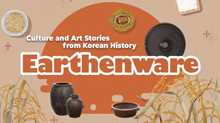 Earthenware08:28
Earthenware08:28 -
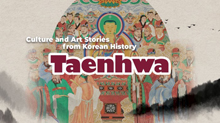 Taenghwa, or Buddhist Paintings in the Joseon Period08:36
Taenghwa, or Buddhist Paintings in the Joseon Period08:36 -
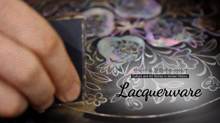 Lacquerware09:04
Lacquerware09:04 -
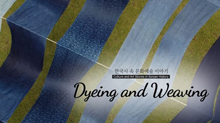 Dyeing and Weaving08:21
Dyeing and Weaving08:21 -
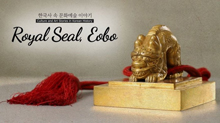 Royal Seal, Eobo07:53
Royal Seal, Eobo07:53 -
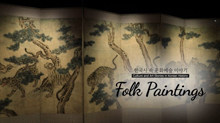 Folk paintings07:49
Folk paintings07:49 -
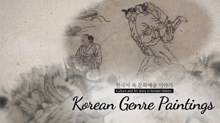 Korean Genre Paintings10:05
Korean Genre Paintings10:05 -
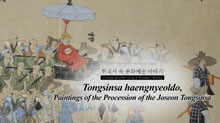 Paintings of the Procession of the Joseon Tongsinsa10:09
Paintings of the Procession of the Joseon Tongsinsa10:09 -
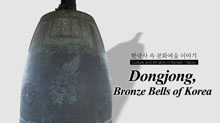 Dongjong, Bronze Bells of Korea08:50
Dongjong, Bronze Bells of Korea08:50 -
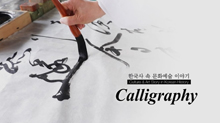 Calligraphy08:32
Calligraphy08:32 -
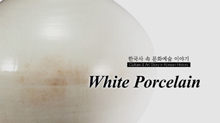 White Porcelain08:18
White Porcelain08:18 -
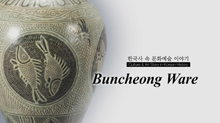 Buncheong Ware07:48
Buncheong Ware07:48 -
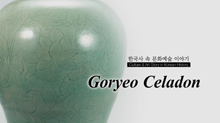 Goryeo Celadon07:54
Goryeo Celadon07:54 -
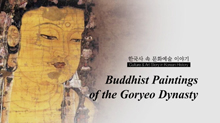 Buddhist Paintings of the Goryeo Dynasty07:57
Buddhist Paintings of the Goryeo Dynasty07:57 -
 Clay Figures, Figurines07:01
Clay Figures, Figurines07:01 -
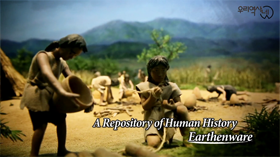 Clay Earthenware06:05
Clay Earthenware06:05 -
 Paintings of the Joseon Dynasty08:09
Paintings of the Joseon Dynasty08:09 -
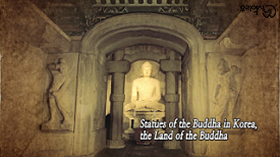 Statues of the Buddha in Korea09:03
Statues of the Buddha in Korea09:03

